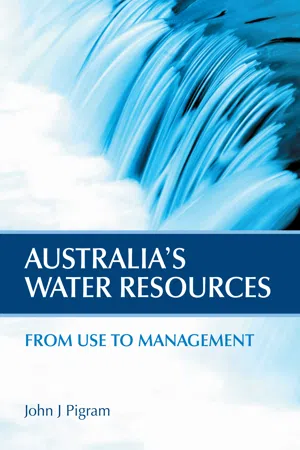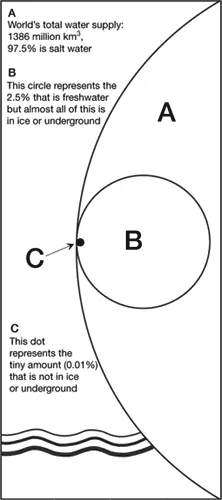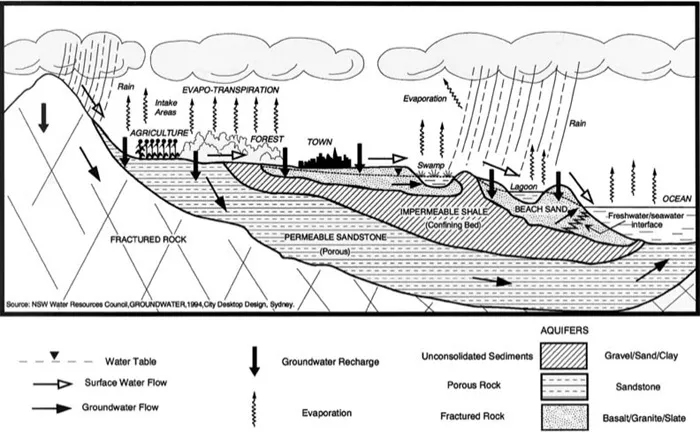![]()
Chapter 1
Water resources in time and space
Introduction
Water is a basic component of human existence and the support systems on which people depend. Along with air, water is one of the most fundamental requirements for the survival of living things. No other single substance has a greater impact on the environment and the uses to which it is put. Water not only moulds the landscape, but also influences the pattern of activities that humans can undertake.
Water occurs in different forms across the Earth. The greatest proportion of the world’s water, approximately 97.5 per cent, is held in the oceans and inland lakes and waterways. Only a very small part of the total is fresh water and much of this is locked up in ice caps, glaciers, the atmosphere, the soil or deep beneath the ground (Figure 1.1).
Figure 1.1 Global water system. These circles show just how little of the world’s total water supply (A) is fresh water (B) and little of that amount is actually usable fresh water (C). Source: Environment Canada n.d.
Thus, despite an apparent abundance of water, the greater part ‘is available at the wrong place, at the wrong time or with the wrong quality’ (Falkenmark and Lindh 1974, p. 114). Writing more recently, Falkenmark (2000) pointed out that whether water is scarce or abundant depends on the characteristics of the freshwater resources under consideration. She points out that past water management has focused on liquid ‘blue water’ flows, ignoring the vapour flow of so-called ‘green water’ that helps to sustain plant production and ecosystems. Falkenmark maintains that global green-water flow is almost twice as large as the gross blue-water flow. Sharing the green-water resource, rather than simply manipulating accessible blue-water flows, should be a long-term priority in managing water in river basins. This perspective adds a new dimension to the hydrologic cycle (see Figure 1.2 below) in which a larger proportion of green-water flow might be appropriated for human use instead of diverting blue water, which can cause downstream river depletion and resource degradation.
Human use of water resources
Despite these revealing insights into the occurrence of water, people still seem most concerned about the quantity and quality of accessible, uncontaminated, liquid fresh water available for use at the Earth’s surface. The picture is complicated by contrasting demands placed on the available fresh water. These demands depend upon population characteristics and economic and socio-cultural levels of development. In effect, the same amount of available water can represent different levels of resource potential to different groups (see below). Particular difficulties can arise when people choose to live in an area with an inadequate water supply, or where water-intensive agriculture or industry imposes heavy demands on a limited water supply.
A distinction can be made between extractive uses for domestic, agricultural or industrial purposes that remove water from its source; on-site uses of water consumed by wetlands, riparian vegetation and evaporation; and in-stream or flow uses, including water for navigation, waste dilution, hydro-electric power and recreation (United States National Water Commission 1973).
Another useful distinction commonly made is between so-called ‘consumptive’ uses of water and ‘non-consumptive’ uses. In the first category, the ‘consumed’ water is not necessarily used up, although its capacity to function as a resource can be impaired. The water may be wholly or partially processed, contaminated or otherwise transformed. Some of the water withdrawn in this way could be returned to the atmosphere by evapotranspiration, incorporated into finished products or returned to circulation as drainage water or groundwater. In non-consumptive usage, water quantity and quality remain largely unaffected and the water is used essentially in its original setting.
These broad categories conceal great variations in patterns of water use, regionally and during different phases of economic growth and change. Countries at an early stage of development use water principally for domestic supply, primary production, fishing, water transport and, perhaps, for simple energy generation. However, as noted earlier, developed economies impose heavier demands on water and have more complex patterns of usage. For example, the comparatively minute water needs of a primitive village are multiplied many times in contemporary households in the industrialising world, with sewerage systems, washing machines, dish-washers and sink disposal units, not to mention swimming pools, spas and expanses of landscaped lawns and gardens.
However, even residential water demands become insignificant when compared with the massive amounts of water consumed in agriculture. On a global scale, agricultural use accounts for up to 80 per cent of total water withdrawals, with the greatest demands being made by irrigation for intensive production of food and fibre. Even assuming significant advances in the efficiency of water use (see Chapter 7), agriculture will continue to use large amounts of water for the foreseeable future (Lvovitch 1977).
Until recently, the focus of most conflicts over water was on consumptive uses, such as those in agriculture or industry. These claims are now being challenged by demands on water for non-consumptive uses, such as in nature conservation, habitat protection or outdoor recreation (see Chapter 9). The greatest pressure on water for these purposes comes from the highly industrialised nations of the Western World, including Australia. Indeed, this increasing concern over environmental quality has been portrayed by some as a privileged class movement capable of being articulated only by fortunate leisured groups in developed economies (Harry, Gale, and Hendee 1969). Certainly, the strongest challenges being mounted against further appropriations of water for consumptive use are in places like Australia and North America. To concerned groups in these countries, water is an integral part of the natural environment and is valued for its ecological and scenic functions. For these groups, water offers opportunities for aesthetic appreciation and outdoor recreation in a wilderness, or at least relatively undisturbed, setting. Conflict is inevitable between proponents of this viewpoint and those who value water for more materialistic uses.
Water as a resource
The function and value of water as a resource depend upon its form, characteristics and location in relation to human needs. The mere physical presence of a body of water does not constitute a resource. Any number of attributes or constraints, such as size, depth, quality or accessibility, may prevent the water from being used as a resource. Creative use of a potential resource requires the satisfaction of certain conditions. In particular, the existence of an appropriate socio-economic and cultural frame of reference is necessary, in which water, in common with other elements of the environment, can acquire a function as a means of production, or for the attainment of other socially valued goals.
Consideration of resource phenomena in functional terms helps explain the changing roles and fluctuating values associated with water over time and space. To a marked degree, resource functions are dynamic, reacting to changes in economic, social and technological conditions and contrasting perceptions among potential user groups. Materials, once seen as valuable resources, can lose their value and be discarded as substitutes are found. Charcoal and flint are examples of materials that once functioned as important resources, but are now no longer needed. Similarly, water resources that are currently viewed as valuable can lose their function when circumstances change, as demonstrated by the de-commissioning of dams and reservoirs. On the other hand, previously neglected potential resources may be harnessed to meet emerging demands (Pigram 1986).
The dynamic character of water as a resource can readily be demonstrated by reference to the range of functions identified with particular streams or water-bodies over time. A river, perhaps initially valued as a convenient water supply, may subsequently acquire a function as a means of transport, a source of power, or even as a waste disposal site. The emerging roles of water for outdoor recreation and as a focus of environmental interest are further evidence of the way in which changing perceptions of the resource are reflected in pressures to adjust its function.
Equally fascinating is the existence of contrasting interpretations placed on an essentially homogeneous resource base. Water resources, again, are a good illustration. For example, the same physical attributes of a river valley may be viewed differently by those inhabitants prepared to take advantage of the opportunities offered. Different groups of people occupying the same environment may perceive totally different resource potential. For some, a valley and its waters represent a tranquil and productive setting in which to carry on traditional farming pursuits. For others, the waters of the valley are there to be harnessed for intensive irrigated agriculture (see Chapter 7). Contrasting perceptions of what are seen as appropriate resource functions for water help explain conflicts that arise over its allocation and use. This theme will recur frequently in the issues examined in later chapters.
Given these contrasting attitudes to water and the diversity of functions perceived for this versatile resource, it is not surprising that disputes arise over its allocation and distribution. The availability of water and its occurrence in nature cannot always provide for all the demands made upon it. For this reason, people seek to interfere in the operation of the hydrologic cycle to store, regulate, divert and drain water in an attempt to bring some degree of control over particular elements of the system to meet human needs. Not all of these efforts are carefully planned, coordinated or implemented. Human intervention in the hydrologic cycle helps explain many of the water-related problems discussed in this book.
The hydrologic cycle
Powered by the sun, the hydrologic cycle, (Figure 1.2) is the endless circulation of water and water vapour from the atmosphere to the Earth, and back again, through the processes of condensation, precipitation, evaporation and transpiration. The sun’s radiation provides the energy for evaporation of moisture from the hydrosphere (principally the oceans) and for the redistribution and circulation of water vapour across the globe. Much of the water returns to the surface of the Earth via condensation and precipitation. Most of the precipitation falls in the seas, but that portion falling on the land surface and vegetation represents the ongoing replenishment of the freshwater resources on which life depends.
The hydrologic cycle is a dynamic system involving the transfer and exchange of moisture from one state and one phase of the cycle to another. Although the rate of water turnover in any particular phase is highly variable, the total amount of water in circulation does not alter in any meaningful sense. The hydrologic cycle is the key to the Earth’s climates and is the prime mover of solar energy around the globe. Without it, and the accompanying greenhouse effect, large parts of the world would be uninhabitable.
Figure 1.2 The hydrologic cycle
Yet, the operation of the cycle, and, hence, the availability of water, are by no means uniform. If the hydrologic cycle were regular and predictable, human settlement and resource use, both in the short and longer term, could adjust to the global distribution of fresh water. Fluctuations, however, do occur and should be expected. Human activities, such as modification of vegetation and soil cover, can have an indirect effect on the natural processes involved in the water cycle. This may change the pattern of circulation or the quality of water. Moreover, settlement patterns and cultural practices may contribute to atmospheric changes, at least at the microlevel, and ultimately to the rate and characteristics of water passing through the system.
Even if left undisturbed by human actions, spatial and temporal aberrations in the natural workings of the cycle can still lead to widespread flooding or prolonged drought. The abrupt reversal of seasonal conditions from time to time in inland Australia – from disastrous drought to equally catastrophic floods – is a good illustration of the fickle nature of the hydrologic cycle (see Chapter 2). It is precisely such departures from the ‘norm’, especially in situations of expanding demand for water, that provide the rationale for attempts at human intervention in the cycle’s operation. For example, the risk of recurring water surplus is used to justify calls for flood mitigation measures and drainage schemes. On the other hand, the probability of frequent periods of drought may prompt the construction of water storages and regulatory works, development of irrigation schemes and widespread utilisation of groundwater.
Quite apart from mitigation measures initiated in reaction to extremes of weather and climate, some ambitious water-management projects have also been undertaken as part of a comprehensive approach to drainage-basin planning. Such schemes are typically large in scale and can involve massive diversion works and widespread alteration to natural drainage patterns. Examples include the Central Valley Project in California and the Snowy Mountains Scheme in Australia (see Chapter 6).
Some of the most significant and effective efforts to manipulate the hydrologic cycle occur in the run-off phase, that is, after the water has reached the Earth’s surface and before it has been transferred to the oceans or to groundwater storage, or returned to the atmosphere. Examination of the various segments of the cycle shows that this phase offers the most obvious potential for reorganisation of water resources in closer alignment with human needs. In simple terms, intervention commonly takes the form of delaying run-off by means of storages of some kind to allow diversion of stream flow to specific areas for specific purposes. Dams are constructed, regulatory and diversion works are built, and pumps and reticulation systems are installed for the transfer and release of water to rural and urban end-users (Figure 1.3).
Intervention has been attempted in other phases of the cycle and can take various forms. Desalination, particularly of sea water, is probably the most effective measure, although the costs, in terms of economics and energy requirements, and environmental implications, make the realisation of net benefits a debateable proposition (see Chapter 5). Rainmaking – the artificial inducement of condensatio...


